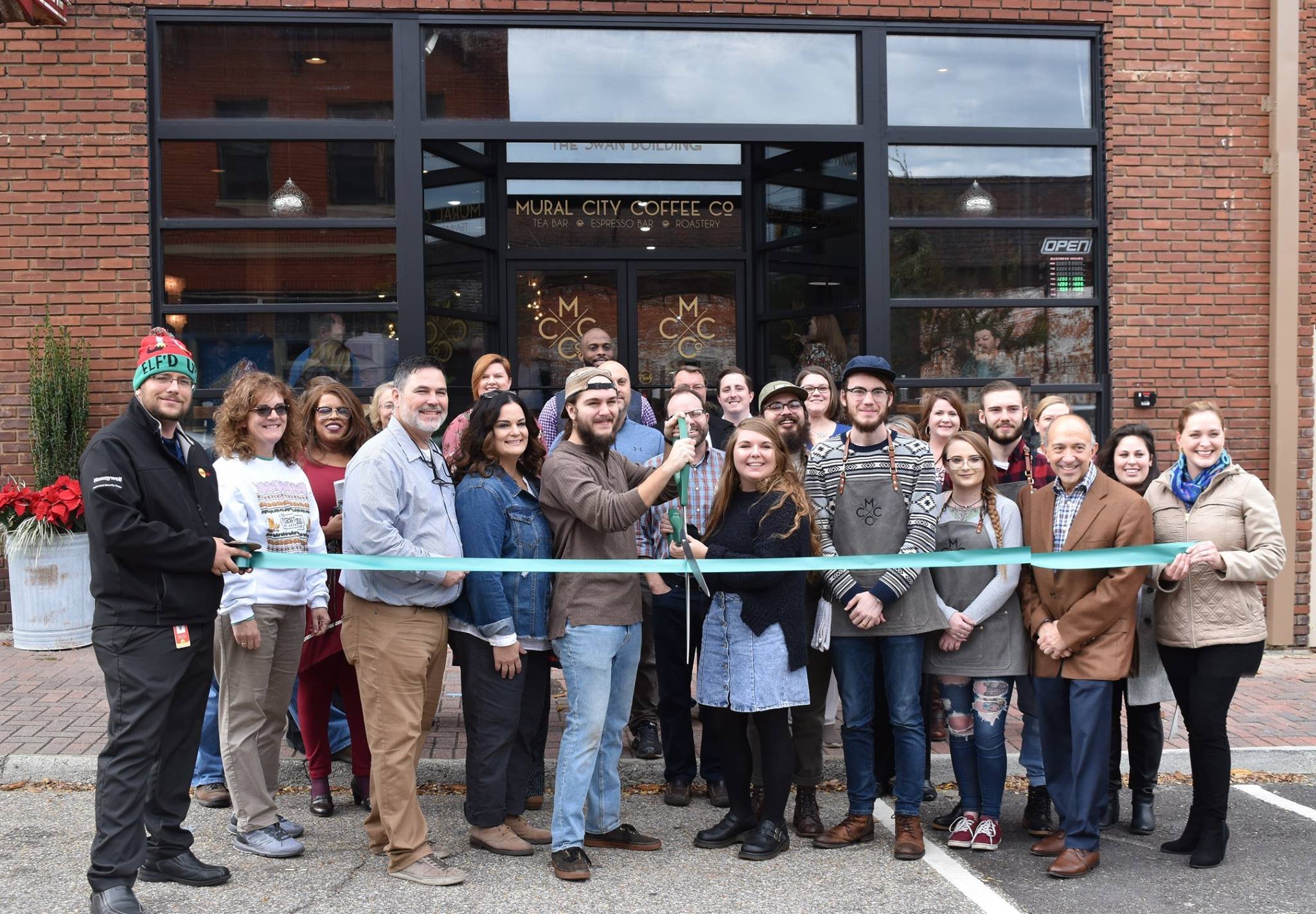The History of
Mural City Coffee Company and the
Revitalization of a Relic
(Written by Chris Warren of Preservation Magazine with additions by Destiny Swan [Hosmer], CBDO of MCCC)
The roots of Mural City Coffee Company—a name taken from Dothan’s myriad wall-sized murals depicting historic events and prominent people in the area—can be traced to places as disparate as Iowa and Germany. Unlike many other historic preservation projects of this size, the transformation of the building into a vibrant spot for locals to drink coffee and tea, hold meetings, display art, and host poetry readings was one family’s do-it-yourself labor of love.
The idea that a café should be a venue for personal connections took deep root in the Swan Family. Creating that experience in an abandoned building filled with decades-old electronics, boxes of packing peanuts, and baby pools to catch leaks required all the passion and skills the Swans had accumulated over time… It also necessitated some not-inconsequential risk. In order to fund the renovation of the building, the Swans had to sell their house. They also had to convince a bank to fund their efforts. Pitches to local banks fell flat (one banker told them he just didn’t understand coffee well enough) until they met with Charles D. Harper, who had worked with couple Darrin and Gina Swan on a vacation rental property they once operated.
So they bought the building, which is a contributing structure to Dothan’s Main Street Commercial District, listed on the National Register of Historic Places, and invited their son, Zach Swan, and girlfriend (now wife) Destiny Hosmer, to move from Birmingham, AL to help tackle the project. They got to work removing all the trash, a necessary precursor to the real task of refurbishing and repurposing the building for its new life.
Initially, the Swans brought in contractors to bid on different jobs, like cleaning the wood floors. One contractor suggested using a pressure washer, which would have cleaned the floors but also damaged them. Instead, the family did research into preserving old floors using a gentler process called soda blasting.
Armed with that information, Zach, now Roaster and COO, spent six months soda blasting every piece of wood in the building—learning about halfway through that wearing goggles and a full body suit would help prevent skin rashes. Another contractor said it would cost $12,000 to sand the floors, a take-it-or-leave-it estimate that didn’t allow for preserving old ruts, paint splatters, and other markings. Instead, the Swans purchased a used sander and did it themselves.
Architect Jason Schmidt and mechanical engineer Ed Locke helped the Swans obtain building permits, research building codes, and work with the local historic preservation committee. Even when they had to rely on the work of subcontractors, The Swans insisted on control over how the building was treated. New plumbing was needed, and they required that the contractor use materials appropriate to the era in places where the pipes were exposed. “We wanted copper pipes, and they were like, ‘It’s easiest to put up PVC,’” recalls Darrin, co-founder and CFO. “We don’t want the easiest; we are going for aesthetics and what it would have been like in the past.”
Even though the Swans removed some of the existing building materials, they tried hard to salvage and repurpose. For example, they took out some of the floors on the second level to usher in more natural light, and incorporated that wood into the staircase leading to the second floor the coffee shop. Other reclaimed wood was used to construct the bakery case, the cabinets holding Mural City Coffee merchandise, and shelving in the tea bar. While the tin first-floor ceiling was beautiful, it obscured water damage, so they pried it out carefully and reused some of it on a second-floor wall. Other tin tiles were supplied to a neighboring café in exchange for free meals.
It wasn’t just materials that were repurposed to give the building its eclectic and historic look. A Singletary & Whiddon vault has been transformed into a surprisingly cozy reading room. The thick, black door emblazoned with the company’s name remains, and the exposed brick on the inside of the vault is now bathed in soft light and lined with inviting bookshelves and cushy seats.
When they had to look outside the building for furnishings, the Swans prioritized vintage items. For instance, a 1950s-era card catalogue from the University of Georgia now holds information about the teas served at the shop. All the cups and carafes are midcentury, and the circa-1950 bullet trash cans now emblazoned with the Mural City logo were salvaged from the University of Iowa.
The family hopes that the hub of activity and enthusiasm they create at Mural City will spill over to the surrounding downtown area... It’s all part of a larger effort to bring people downtown to live, work, and play. And if the scene that develops at Mural City each day once the doors open is any indication, there’s a real chance of success. A line typically stretches from the counter to the front door, and the crowd is as eclectic as its surroundings. The day I visit the coffee shop, there are plenty of young medical students, and older ladies who had driven off earlier (after arriving prior to opening) return and occupy a table. Couples and young families also arrive and gaze around at the art on the walls and the vintage furnishings. Nobody seems in a hurry… which is just what the Swans wanted.
The 1920s structure has gone from an agricultural supply company to a defunct electronics store with a leaky roof to a coffee-and-tea emporium that rivals anything in San Francisco, New York, or Seattle.


